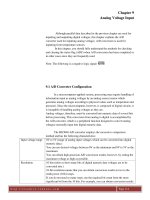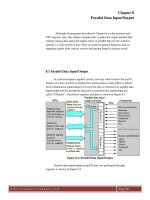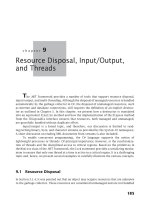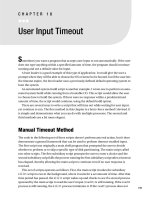Read Piped Input
Bạn đang xem bản rút gọn của tài liệu. Xem và tải ngay bản đầy đủ của tài liệu tại đây (49.01 KB, 2 trang )
183
■ ■ ■
CHAPTER 27
Read Piped Input
M
any programs available to the UNIX or Linux operating systems have the ability to
process input from standard input through a pipe, Similarly, the following short script
demonstrates how to perform this task using a shell script. The script also demonstrates a
number of interesting techniques that are covered in more depth elsewhere in this book.
The purpose of the script is to take its input, whether from a file or stdin, and print the
data to stdout in reverse order. The script provides two ways to perform this task. The first
method works by calling the script with an argument that is the name of the file to be
reversed. Alternatively, you can pipe output from some other command into the script,
and it will then perform the reversal on its standard input.
First we initialize a counter variable that will track the lines of input the script receives.
#!/bin/sh
counter=0
Next we define the populate() function.
populate () {
counter=$(($counter+1))
eval COUNT${counter}='$LINE'
}
This function creates a new variable by calling the eval command. The eval command
performs variable and metacharacter expansion in what follows before passing the result
to the shell to evaluate; it is used here to construct a line of code (an assignment state-
ment) out of the contents of preexisting variables. This is a fairly powerful method for
creating command lines at runtime and is explained in more detail in Chapter 7.
The populate() function first increments the counter variable and then creates
a variable called COUNTnn where nn is the value of the counter that in this case refers
to the specific line of input to be reversed. The collection of these variables behaves
analogously to an array, except that the limit on the number of elements is based on the
amount of memory the shell makes available rather than the preset limit for the shell’s
array construct.
1
1. The maximum number of elements in an array in
ksh88
is 1024. In
ksh93
, it is increased to 4096.
bash
has no range limit.
184
CHAPTER 27
■
READ PIPED INPUT
Now we check to see whether a filename has been passed to the script.
if [ "$1" != "" ]
then
if [ -f $1 ]
then
while read LINE
do
populate
done < $1
else
echo "$1 Does not exist, please try again"
fi
If it has, the script tests whether the file exists. If the file is validated, the script redirects
it into the back end of the while loop. This loop calls the populate function for each line of
the file. If the file named in the command line doesn’t exist, we just output a simple error
message.
You may think performing a cat of the file and piping the result into the front of the while
loop would work, but this can have unforeseen results. It works in ksh without a hitch, but
not in pdksh or in bash. (For more information about piping data into a while loop, see
Chapter 10.) Redirecting the file into the back end of the while loop always works.
If no filename was passed to the script from the command line, we assume the data is
being piped into the script.
else
while read LINE
do
populate
done
fi
Each line is read in sequence, and the populate function is called to expand the vari-
ables to their values.
Once the script has finished processing all the data, the counter variable contains the
number of the last line of data that was processed.
while [ $counter -gt 0 ]
do
eval echo '$COUNT'$counter
counter=$(($counter-1))
done
This while loop then counts down from the counter value, decrementing by one each
time, outputting the contents of each of the newly created variables. Thus we reverse the
order of the lines from the input.









